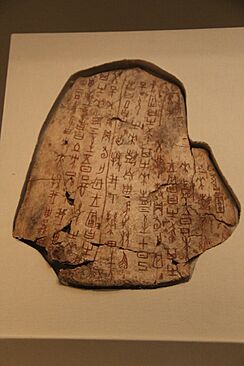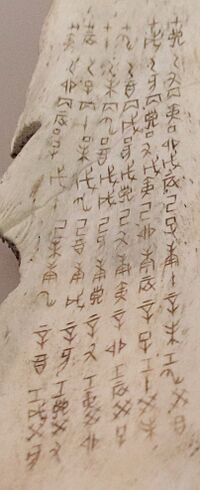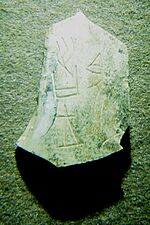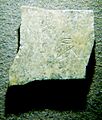Oracle bone script facts for kids
Quick facts for kids Oracle bone script |
|
|---|---|
 |
|
| Type | Logographic |
| Spoken languages | Old Chinese |
| Time period | c. 1250 – c. 1050 BC |
| Child systems | Seal script |
| Note: This page may contain IPA phonetic symbols in Unicode. | |
| Oracle bone script | |||||||||||||||||||||||||||||||||||||
|---|---|---|---|---|---|---|---|---|---|---|---|---|---|---|---|---|---|---|---|---|---|---|---|---|---|---|---|---|---|---|---|---|---|---|---|---|---|
| Chinese | 甲骨文 | ||||||||||||||||||||||||||||||||||||
| Literal meaning | shell and bone script | ||||||||||||||||||||||||||||||||||||
|
|||||||||||||||||||||||||||||||||||||
Oracle bone script is the earliest known form of written Chinese. It dates back to the late 2nd millennium BC, around 1250 to 1050 BC. People carved these ancient characters onto oracle bones. These bones were usually the shoulder blades of oxen or the bottom shells of turtles.
The writings mostly recorded the results of official divinations. These were like fortune-telling sessions for the Late Shang royal family. The process was called scapulimancy. People would heat the oracle bones until cracks appeared. Then, they would interpret these crack patterns. Both the question asked and the interpretation were carved onto the same bone.
Most of these ancient inscriptions, about 150,000 of them, were found at Yinxu. This was the last capital city of the Shang dynasty. Today, it's known as Anyang in Henan, China. The most recent big discovery was in 1993, where 579 inscribed pieces were found. The inscriptions mention the last nine Shang kings, starting with Wu Ding. His rule began around 1250 to 1200 BC.
The oracle bone inscriptions are the oldest collection of Chinese writing. They are the direct ancestors of all Chinese family of scripts that developed over the next 3,000 years. Studying them helps us understand how Chinese words and characters changed over time. These inscriptions also influenced many other writing systems in East Asia. Most inscriptions are 10 to over 100 characters long, but usually around a few dozen. They cover many topics, like wars, farming, births, illnesses, and deaths in the royal family. This gives us amazing insights into what life was like in the late Shang society.
Contents
What is Oracle Bone Script Called?

The common Chinese name for oracle bone script is 甲骨文 (jiǎgǔwén). This means 'shell and bone script'. It's a shorter way of saying 'turtle-shell and animal-bone script'. This name came from an English phrase, "inscriptions upon bone and tortoise shell." An American missionary named Frank H. Chalfant created this phrase in 1906. Chinese books started using the translated term in the 1930s.
Before that, Chinese scholars used different names. These names often related to where the bones were found (Yinxu), their purpose (divination), or how they were made (engraving). A common older term was 殷墟卜辭 (Yīnxū bǔcí), meaning 'Yinxu divinatory texts'.
Studying Oracle Bones: Oraculology
Oraculology (甲骨学; 甲骨學; jiǎgǔxué) is the study of oracle bones and the script written on them. It's a field of study that focuses on ancient Chinese history and writing. This field looks at the oracle bone script itself. It also combines ideas from history, archaeology, and cultural studies. This helps scholars understand the historical and cultural background of the oracle bones.
Where Did Oracle Bone Script Come From?
Most experts agree that the oracle bone script existed before the oldest known examples. This is because the script found is already very developed. Many characters were already simplified. Also, ways of using words for new meanings or sounds were already common. This suggests the script had been developing for centuries.
However, no clear examples of writing from before the 13th century BC have been found. Some inscribed symbols on pottery, jade, and bone have been found at older sites in China. But these have not been proven to be directly related to the Shang oracle bone script found at Anyang.
How Oracle Bone Script Looks
The oracle bone script from the Late Shang period looks like pictures. The earliest forms look even more like pictures than later ones. This means the script changed over its 200-year history. Compared to writing on bronze objects from the same time, oracle bone script is much simpler. Rounded shapes often became straight lines. This is probably because carving on hard bone was difficult. Writing on wet clay for bronze casting was much easier.
The Shang people also wrote with brushes and ink. Brush-written characters have been found on pottery, shells, bones, and jade. There's also evidence they wrote on bamboo books. These were similar to books found from later periods. This is known because oracle bone inscriptions show characters for a writing brush and for a bamboo book.
Writing with a brush is easier than carving. So, it's believed that most Shang writing was done with brushes on bamboo books. The style and structure of these characters were likely similar to those on bronzes. Some characters in oracle bone script are even rotated 90 degrees. This might be to fit better on tall, narrow bamboo strips. The way characters are written in columns, from top to bottom, also comes from bamboo books. Sometimes, characters are written in rows to match cracks on the bones. But they were never read from bottom to top.
How Oracle Bone Script Works
Even though oracle bone script looks like pictures, it was a complete writing system. It could record the Old Chinese language fully, not just bits of ideas. This means it must have developed for hundreds of years before the Shang dynasty. Many characters were already simplified. For example, without careful study, you might not know that some characters meant 'swine' or 'dog'. While they started as pictures, they functioned more as symbols for words.
By the late Shang period, oracle bone characters had changed. They included all the main types of Chinese characters still used today. This includes characters that combine meaning and sound. One study found that 23% were pictographs (pictures), 32% were associative compounds (combining ideas), and 27% were phono-semantic compounds (combining sound and meaning).

The oracle bone script was not fully standardized. There were many different ways to write the same character. The size and direction of characters were also not regular. For example, a character turned upside down often meant the same word. These differences lasted until the seal script was standardized during the Qin dynasty.
Over 30,000 different character forms have been found. These represent about 4,000 individual characters. Many of them are still a mystery to scholars. However, experts believe they can understand between 1,500 and 2,000 characters. It's hard to figure them out because parts of some oracle bone characters look different in later forms. For example, the modern character for 'autumn' (秋) has parts for 'plant stalk' and 'fire'. But the oracle bone form shows an insect, sometimes with fire below it.
Some characters are only found in oracle bone script. They were not used later and were replaced by newer characters. For these, scholars use the surrounding text to guess their meaning. Sometimes, if a character is a sound-and-meaning compound, a general meaning can be figured out. For instance, a recently found character had a 'mound' component. Since the divination was about the king traveling for a hunt, it was likely a place name.
Oracle Bones from the Zhou Dynasty
There are very few oracle bone inscriptions from after the Zhou dynasty took over from the Shang (around 1046 BC). For a long time, only a few small fragments were found. But in August 1977, thousands of Zhou-era oracle bones were discovered. About 200-300 of these had inscriptions.
Who Studied Oracle Bones?
Many important scholars helped us understand oracle bone writings. Here are some of them:
- Wang Yirong was the first to realize these characters were ancient Chinese writing in 1899.
- Liu E collected many fragments and published the first collection in 1903. He correctly identified 34 characters.
- Luo Zhenyu collected over 30,000 oracle bones. He identified the names of the Shang kings, proving the bones were from the Shang period.
- Wang Guowei showed that the list of Shang kings on the bones matched historical records.
- Dong Zuobin helped figure out who the diviners were and created a timeline for the oracle bones.
- Guo Moruo edited the largest collection of published oracle bones.
- Ken-ichi Takashima was the first to study the language of the oracle bones using modern language science.
Oracle Bone Script on Computers
There is a plan to add the oracle bone script to Unicode. This would allow these ancient characters to be used and displayed on computers and digital devices.
Images for kids
-
Tortoise plastron with divination inscription dating to the reign of King Wu Ding



















